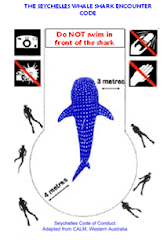Dr. Bruce Carlson, Chief Science Officer at the Georgia Aquarium, and Dr. Rebecca Stone, Curator of the Art of the Ancient Americas at the Carlos at the Michael C. Carlos Museum at Emory University, recently made a presentation about linkages between zoology and ancient Latin American shamanism, particularly about whale sharks.
Contrary to previous understanding, including her own, Dr. Stone now believes that a centuries-old statue of a female shaman (Mayan priestess) is modeled after whale shark anatomy.
Recent research and conversation with Dr. Carlson has led Dr. Stone to re-evaluate the imagery on the ceramic female shaman effigy in the collection, and to interpret her shape and markings as representing a whale shark. The statue was originally thought to represent a jaguar, a “power animal” commonly revered in Mayan and Aztec art. This idea is supported to some extent by the annual aggregations of whale sharks off the Yucatan peninsula in the Mexican Caribbean and off the coast of South America.
However, this is not the only inclusion of whale sharks in spiritual or traditional art. From central India comes the Timingila Jataka Medallion from among the Bharut reliefs of Buddhist origin which date back to the second century BC. The medallion depicts three men in a boat being swallowed by a large fish (the Timingila) which on its interpretation in 1956, by Sunder Lal Hora, was likened to a whale shark:
“When the fish inhales water for oxygenating its gills, the power of suction is so great that a small boat with three occupants could be sucked into its cave-like mouth as is so clearly shown on the medallion.”
 A rubbing of the Timingila Jataka Medallion from the Buddhist Bharut reliefs, courtesy British library
A rubbing of the Timingila Jataka Medallion from the Buddhist Bharut reliefs, courtesy British library The likelihood of whale sharks being known from India is also very high as they have long been associated with the Gujarat coast and so are likely to have been encountered by the Indian fishermen and were probably thus woven into such ancient legends and beliefs. Scholarly translations of the texts from these reliefs vary in their interpretation of the medallion, but a Chinese Buddhist translation is the shortest and most simple:
“Five hundred merchants start on a sea-voyage. The ship comes near a giant fish which swallows the waves together with all living animals contained in them. With an irresistible force the ship also is drawn into the throat of the gigantic fish. In vain the merchants pray to the different gods, whom they worship, then the captain of the boat says to them that he knows of a great god called Buddha. They should pray to him in place of other gods. There- upon all the merchants together shout ' namo Buddhdya ' In this way the fish learns that a Buddha has again appeared in the world. It realizes that it would be improper to do any harm to the living beings; it therefore shuts the mouth so that the water begins to flow back and the ship is saved. The fish really has been a monk in its former birth. The name of the Buddha reminds it of its former existence and this led it to the decision to spare the life of the beings.”
Most translations agree on the continuation of the story where the gigantic fish starves itself to death and is reborn once again as a Buddhist monk (Dharmaruchi) who is revered through out Buddhism.
While I’m not completely sold on the idea that whale sharks are re-incarnated Buddhist monks it certainly seems that the monks were aware of whale sharks many, many centuries ago.
Quotations on the translations of the Timingila Jataka Medallion courtesy of the ‘Corpus Inscription Indicarum, vol. II, part II, Bharhut Inscriptions edited by H. Luders’ and image of the Medallion courtesy of the British Library.


1 comment:
Monks...... And Mayans.....
Post a Comment